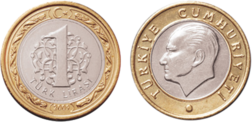Turkish lira
| Turkish lira | |||
|---|---|---|---|
| Türk lirası (Turkish) | |||
|
|||
| ISO 4217 Code | TRY | ||
| User(s) | |||
| Inflation | 5.24% (Turkey, May 2009) | ||
| Source | [1] NTVMSNBC | ||
| Subunit | |||
| 1/100 | kuruş | ||
| Symbol | TL | ||
| Coins | |||
| Freq. used | 10, 25, 50 Kr , 1TL | ||
| Rarely used | 1 Kr 5 Kr | ||
| Banknotes | |||
| Freq. used | 5TL, 10TL, 20TL, 50TL | ||
| Rarely used | 100TL, 200TL | ||
| Central bank | Central Bank of the Republic of Turkey | ||
| Website | www.tcmb.gov.tr | ||
| Printer | CBRT Banknote Printer | ||
| Website | www.tcmb.gov.tr | ||
| Economy of Turkey
|
|---|
Money
|
|
Projects
|
|
Companies
|
|
Tourism in Turkey |
|
Other Turkish topics |
|
Culture – Education |
The Turkish lira (Turkish: Türk lirası) is the currency of Turkey and the de facto independent state of the Turkish Republic of Northern Cyprus. The lira is subdivided into 100 kuruş. The symbol is TL and the ISO 4217 code is TRY.[1]
Contents |
History
First lira
The lira was introduced in 1844. It replaced the kuruş as the principal unit of currency, with the kuruş continuing to circulate as a subdivision of the lira, with 100 kuruş = 1 lira. The para also continued to be used, with 40 para = 1 kuruş. Until the 1930s, the Arabic script was used on Turkish coins and banknotes, with پاره for para, غروش for kuruş and ليرا for lira (تورك ليراسي for "Turkish lira"). In European languages, the kuruş was known as the piastre, whilst the lira was known as the livre in French.
Between 1844 and 1881, the lira was on a bimetallic standard, with 1 lira = 6.61519 grams pure gold = 99.8292 grams pure silver. In 1881, the gold standard was adopted and continued until 1914. World War I saw Turkey effectively depart from the gold standard with the gold lira being worth about nine lira in paper money by the early 1920s.
After periods pegged to the British pound and the French franc, a peg of 2.8 lira = 1 U.S. dollar was adopted in 1946 and maintained until 1960, when the currency was devalued to 9 lira = 1 dollar. From 1970, a series of hard, then soft pegs to the dollar operated as the value of the lira began to fall.
Because of the chronic inflation experienced in Turkey from the 1970s through to the 1990s, the lira experienced severe depreciation in value. Turkey has had high inflation rates compared to developed countries but has never suffered hyperinflation. From an average of 9 lira per U.S. dollar in the late 1960s, the currency came to trade at approximately 1.65 million lira per U.S. dollar in late 2001. This represented an average inflation of more than 40% per year.
- 1966 — 1 U.S. dollar = 9 lira
- 1980 — 1 U.S. dollar = 90 lira
- 1988 — 1 U.S. dollar = 1,300 lira
- 1995 — 1 U.S. dollar = 45,000 lira
- 1996 — 1 U.S. dollar = 107,000 lira
- 2001 — 1 U.S. dollar = 1,650,000 lira
- 2004 — 1 U.S. dollar = 1,350,000 lira
- 2007 — 1 U.S. dollar = 1.26 new lira (The use of New Turkish Lira, which drops 6 zeros from the currency-Turkish Lira-, is implemented in 2005. Turkish Lira and New Turkish Lira were used together in 2005. After 2009, New Lira was converted to Lira, but New Lira used as currency until 31 December 2009)
- 2008 — 1 U.S. dollar = 1.55 Lira
- 2009 — 1 U.S. dollar = 1.48 Lira
- 2010 — 1 U.S. dollar = 1.517 Lira (Last updated on July 22th, 2010)
In its last few years the Turkish lira stabilized and even rose against the U.S. dollar and the euro. The Guinness Book of Records ranked the lira as the world's least valuable currency in 1995 and 1996, and again in 1999 through 2004. The lira had slid in value to such an extent that one original gold lira coin could be sold for approximately 120,000,000 lira prior to the 2005 revaluation.
Second lira
In late December 2003, the Grand National Assembly of Turkey passed a law that allowed for the removal of six zeroes from the lira, and the creation of a new currency. It was introduced on 1 January 2005, replacing the previous lira (which remained valid in circulation until the end of 2005) at a rate of 1 second lira (ISO 4217 code "TRY") = 1,000,000 first lira (ISO 4217 code "TRL"). With the revaluation of the Turkish lira, the Romanian leu (also revalued in July 2005) briefly became the world's least valued currency unit.
In the transitional period between 1 January 2005 and 31 December 2008, the second lira was officially called Yeni Türk Lirası (New Turkish lira).[2] It was officially abbreviated "YTL" and subdivided into 100 new kuruş (yeni kuruş). With effect from 1 January 2009, the "new" was removed from the second lira, its official name becoming just "lira" again, abbreviated "TL".
Coins
First lira

Between 1844 and 1855, coins were introduced in denominations of 1, 5, 10, 20 and 40 para, ½, 1, 2, 5, 10, 20 kuruş, ¼, ½, 1, 2½ and 5 lira. The para denominations were struck in copper, the kuruş in silver and the lira in gold. The 1 para was discontinued in 1859, with the higher copper denominations ceasing production between 1863 and 1879. In 1899, billon 5 and 10 para were introduced, followed by nickel 5, 10, 20 and 40 kuruş in 1910. The silver and gold coinages ceased production as a consequence of the First World War.
In 1922 and 1923, a new coinage was introduced consisting of aluminium-bronze 100 para, 5 and 10 kuruş and nickel 25 kuruş. These were the last Turkish coins to bear inscriptions in the Arabic script.
In 1934, silver 100 kuruş coins were struck, followed the next year by a new coinage consisting of cupro-nickel 1, 5 and 10 kuruş, and silver 25 and 50 kuruş and 1 lira. Aluminium-bronze 10 para coins were issued between 1940 and 1942, the last coins to bear this denomination. Nickel-brass replaced silver in the 25 kuruş in 1944, with brass 1, 2½, 5, 10 and 25 kuruş introduced between 1947 and 1949. The silver 50 kuruş and 1 lira were discontinued in 1948, with cupro-nickel 1 lira issued in 1957.
Between 1958 and 1963, bronze 1, 5 and 10 kuruş and steel 25 kuruş, 1 and 2½ lira were introduced, followed by steel 50 kuruş and 5 lira in 1971 and 1974, respectively. Aluminium replaced bronze in 1975. These coins were issued up to 1980.
In 1981, with inflation gaining pace, aluminium 1, 5 and 10 lira coins were introduced. Higher denominations followed: 20, 50 and 100 lira in 1984, 25 lira in 1985, 500 lira in 1988, 1000 lira in 1990, 2500 lira in 1991, 5000 lira in 1992, 10,000 lira in 1994, 25,000 lira in 1995, 50,000 lira in 1997, and 100,000 lira in 1999. This culminated in 250,000 lira coins in 2002.
Second lira
2005–2008
In the transitional period between 1 January 2005 and 31 December 2008, the second lira was officially called "new lira" in Turkey. Coins were introduced in 2005 in denominations of 1, 5, 10, 25 and 50 new (yeni) kuruş and 1 new (yeni) lira. The 1 new kuruş was minted in brass and the 5, 10 and 25 new kuruş in cupro-nickel, whilst the 50 new kuruş and 1 new lira are bimetallic. All coins show portraits of Mustafa Kemal Atatürk.
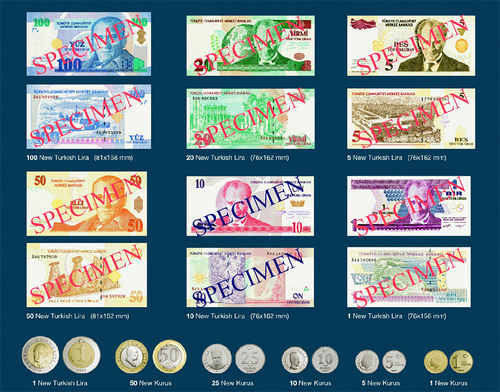
To the dismay of the European Central Bank, the sizes and compositions of the 50 new kuruş and 1 new lira coins clearly resemble those of the €1 and €2 coins respectively. (See comparison photo in [2] of YTL 1 coin and €2 coin.) This could cause confusion in the eurozone. It also caused trouble to businesses using vending machines (particularly at airports) in the eurozone since a number of vending machines at the time accepted the 1 new lira coin as a €2 coin. Since €2 is worth roughly four times more, vending machines affected had to be upgraded at the expense of their owners.
Since 2009
From 1 January 2009, the "new" was removed from the second lira, its official name in Turkey becoming just "lira" again; new coins without the word "yeni" were introduced in denominations of 1, 5, 10, 25, 50 kuruş and 1 lira. Also, the inner and outer alloys of the 50 kuruş and 1 lira coins were reversed.
| Turkish Lira coins after 2009 | ||||||||||||
|---|---|---|---|---|---|---|---|---|---|---|---|---|
| Image | Value | Technical parameters | Description | Date of | ||||||||
| Obverse | Reverse | Diameter | Thickness | Mass | Composition | Edge | Obverse | Reverse | first minting | issue | ||
| 1 kuruş | 16.5 mm | 1.35 mm | 2.2 g | 70% copper 30% zinc |
Plain | Value, motif, year of minting | "TÜRKİYE CUMHURİYETİ", Mustafa Kemal Atatürk |
2008 | 1 January 2009 | |||
| 5 kuruş | 17.5 mm | 1.65 mm | 2.9 g | 65% copper 18% nickel 17% zinc |
Plain | Value, motif, year of minting | "TÜRKİYE CUMHURİYETİ", Mustafa Kemal Atatürk |
2008 | 1 January 2009 | |||
| 10 kuruş | 18.5 mm | 1.65 mm | 3.15 g | 65% copper 18% nickel 17% zinc |
Plain | Value, motif, year of minting | "TÜRKİYE CUMHURİYETİ", Mustafa Kemal Atatürk |
2008 | 1 January 2009 | |||
 |
 |
25 kuruş | 20.5 mm | 1.65 mm | 4 g | 65% copper 18% nickel 17% zinc |
Reeded | Value, motif, year of minting | "TÜRKİYE CUMHURİYETİ", Mustafa Kemal Atatürk |
2008 | 1 January 2009 | |
 |
 |
50 kuruş | 23.85 mm | 1.9 mm | 6.8 g | Outer ring: 65% copper 18% nickel 17% zinc Inner part: 79 % copper 4% nickel 17% zinc |
Reeded | Value, Istanbul, suspension bridge, year of minting | "TÜRKİYE CUMHURİYETİ", Mustafa Kemal Atatürk |
2008 | 1 January 2009 | |
 |
 |
1 lira | 26.15 mm | 1.9 mm | 8.2 g | Outer ring: 79% copper 4% nickel 17% zinc Inner part: 65% copper 18% nickel 17% zinc |
T.C. letters and tulip figure | Value, motif, year of minting | "TÜRKİYE CUMHURİYETİ", Mustafa Kemal Atatürk |
2008 | 1 January 2009 | |
| These images are to scale at 2.5 pixels per millimetre. For table standards, see the coin specification table. | ||||||||||||
Banknotes
Introduction
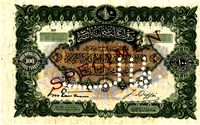
The Banque Imperiale Ottomane (Imperial Ottoman Bank) first issued paper currency Kaime in 1862, in the denomination of 200 kuruş. The notes bore texts in Turkish and French. Notes for 1, 2 and 5 lira were introduced in 1873. In 1876, smaller denomination notes were introduced for 1, 5, 10, 20, 50 and 100 kuruş. In 1908, 50 and 100 lira notes were introduced.
From 1912, the Ministry of Finance issued paper money. Initially, notes were produced in denominations of 5 and 20 kuruş, ¼, ½, 1 and 5 lira, followed the next year by 1 and 2½ kuruş, 2½, 10, 25, 50, 100 and 500 lira. 1000 lira notes were introduced in 1914. In 1917, postage stamp money was issued in the form of 5 and 10 para stamps affixed to card.

In 1926, the Ministry of Finance introduced notes for the Republic of Turkey in denominations of 1, 5, 10, 50, 100, 500 and 1000 lira. These were the last notes printed with both French and Turkish (in the Arabic script) texts on them. Each note carried the portrait of Mustafa Kemal Atatürk.
Between 1937 and 1939, the Central Bank of Turkey introduced new notes with Turkish texts in the Latin alphabet, bearing the portrait of President İsmet İnönü. İnönü notes caused disputes at the time. Denominations of 2½, 5, 10, 50, 100, 500 and 1000 lira were issued. 1 lira notes were reintroduced in 1942, followed by 50 kuruş notes which weren't released in the country due to World War II in 1944. These two lowest denominations were replaced by coins after the War.
Atatürk reappeared on a subsequent series of notes in the early 1950s. The 2½ lira notes were replaced by coins in 1960, with the same happening to the 5 and 10 lira notes in 1974 and 1981. Higher denomination notes were introduced during the 1980s and 90s: 5000 lira in 1981, 10,000 lira in 1982, 20,000 lira in 1988, 50,000 lira in 1989, 100,000 lira in 1991, 250,000 lira in 1992, 500,000 lira in 1993, 1,000,000 lira in 1995, 5,000,000 lira in 1997, 10,000,000 lira in 1999 and 20,000,000 lira in 2001. The higher values of the "E7 Emission Group" banknotes (1992 250,000 TL and later and higher value notes) are exchangeable for new liras at a rate of 1,000,000 lira to 1 new lira at branches of the Central Bank of the Republic of Turkey until 31 December 2015, after which time they will have no value.[3] The 50,000 lira note ceases to be redeemable on 4 November 2009, and the 100,000 lira note on 4 November 2011.[4]
1st Emission Group
| Banknotes of Emission 1 (1927 - 1939) | |||||||
|---|---|---|---|---|---|---|---|
| Image | Value | Dimensions | Main Colour | Description | |||
| Obverse | Reverse | Obverse | Reverse | ||||
| 1 Lira | 90 × 166 mm | Olive green | House of Parliament, Citadel of Ankara, a ploughing farmer | Former Building of Prime Ministry | |||
 |
5 Lira | 94 × 170 mm | Dark blue | The Citadel of Ankara, a grey-wolf and the House of Parliament | A bridge in Ankara | ||
 |
10 Lira | 99 × 175 mm | Lilac | The Citadel of Ankara, a grey-wolf | The Citadel of Ankara | ||
 |
 |
50 Lira | 108 × 185 mm | Brown, olive green | Mustafa Kemal Atatürk | Afyon | |
 |
 |
100 Lira | 112 × 189 mm | Olive green | Mustafa Kemal Atatürk | a village | |
 |
 |
500 Lira | 120 × 194 mm | Brown, yellow | Gökmedrese of Sivas, Mustafa Kemal Atatürk | Sivas | |
 |
 |
1.000 Lira | 124 × 201 mm | Dark blue | Mustafa Kemal Atatürk | A view from the railroad to Sakarya | |
| These images are to scale at 0.7 pixels per millimetre. For table standards, see the banknote specification table. | |||||||
6th Emission Group
| Banknotes of Emission 6 (1970s) | |||||||
|---|---|---|---|---|---|---|---|
| Image | Value | Dimensions | Main Colour | Description | |||
| Obverse | Reverse | Obverse | Reverse | ||||
| 5 Lira | 135 × 60 mm | Purple | Mustafa Kemal Atatürk | Manavgat Waterfall, Antalya | |||
| 10 Lira | 140 × 65 mm | Olive Green | Mustafa Kemal Atatürk | Maiden's Tower, Istanbul | |||
| 20 Lira | 143 × 66 mm | Red, Brown | Mustafa Kemal Atatürk | Anıtkabir, Ankara | |||
 |
 |
50 Lira | 160 × 71 mm | Brown | Mustafa Kemal Atatürk | Marble fountain in the rose garden in front of Yerevan Kiosk, Topkapı Palace, Istanbul | |
 |
 |
100 Lira | 170 × 77 mm | Green, Brown | Mustafa Kemal Atatürk | Mount Ararat | |
 |
 |
500 lira | 170 × 80 mm | Blue, Olive Green | Mustafa Kemal Atatürk | Main gate of Istanbul University | |
 |
 |
1000 lira | 170 × 82 mm | Violet | Mustafa Kemal Atatürk | Bosphorus Bridge, Istanbul | |
| These images are to scale at 0.7 pixels per millimetre. For table standards, see the banknote specification table. | |||||||
7th Emission Group
1980s series
| Banknotes of Emission 7 (1980s) | |||||||
|---|---|---|---|---|---|---|---|
| Image | Value | Dimensions | Main Colour | Description | |||
| Obverse | Reverse | Obverse | Reverse | ||||
| 10 Lira | 122 × 55 mm | Pink, Olive Green | Mustafa Kemal Atatürk | Meeting of him with elementary students. | |||
| 100 Lira | 131 × 61 mm | Red, Brown | Mustafa Kemal Atatürk | Mehmet Akif Ersoy with National anthem of Turkey and his birthplace | |||
 |
 |
500 Lira | 140 × 72 mm | Blue | Mustafa Kemal Atatürk | İzmir Clock Tower | |
 |
1 000 Lira | 140 × 72 mm | Violet | Mustafa Kemal Atatürk | Fatih Sultan Mehmed with Old Istanbul skyline | ||
   |
   |
5 000 Lira | 1st version: 140 × 72 mm Later versions: 146 × 72 mm |
1st version: Brown, orange and blue Later: Green, Brown |
Mustafa Kemal Atatürk | 1st version: Mevlana Mausoleum, Konya 2nd and 3rd version: Same place with Mevlana 4th version: Thermal power station of Afşin - Elbistan |
|
 |
 |
10 000 lira | 146 × 72 mm | Purple, Green | Mustafa Kemal Atatürk | Mimar Sinan the Architect with Selimiye Mosque, Edirne | |
 |
 |
20 000 lira | 152 × 76 mm | Red, Violet | Mustafa Kemal Atatürk | Main Building of Central Bank of Turkey, Ankara | |
 |
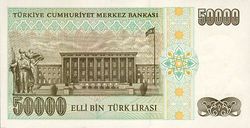 |
50 000 lira | 152 × 76 mm | Green | Mustafa Kemal Atatürk | Turkish Grand National Assembly, Ankara | |
| These images are to scale at 0.7 pixels per millimetre. For table standards, see the banknote specification table. | |||||||
1990-2005 series
The notes were given security features. The latest versions of the 100,000 TL, 250,000 TL, 500,000 TL and 1,000,000 TL notes lost their color-changing ink due to inflation.
| Banknotes of Emission 8 (1990–2005) | |||||||
|---|---|---|---|---|---|---|---|
| Image | Value | Dimensions | Main Colour | Description | |||
| Obverse | Reverse | Obverse | Reverse | ||||
 |
 |
100 000 lira | 158 × 76 mm | Brown Green | Mustafa Kemal Atatürk | Mustafa Kemal Atatürk meeting with elementary school students. | |
 |
 |
250 000 lira | 158 × 76 mm | Blue | Mustafa Kemal Atatürk | Red Tower, Alanya | |
 |
 |
500 000 lira | 160 × 76 mm | Purple, Violet | Mustafa Kemal Atatürk | Battle of Gallipoli Memorial, Çanakkale | |
 |
 |
1 000 000 lira | 160 × 76 mm | Claret Red, Blue | Mustafa Kemal Atatürk | Atatürk Dam (as a part of Southeastern Anatolia Project) | |
 |
 |
5 000 000 lira | 162 × 76 mm | Pastel yellow and greenish brown | Mustafa Kemal Atatürk | Anıtkabir, Ankara | |
 |
 |
10 000 000 lira | 162 × 76 mm | Red | Mustafa Kemal Atatürk with Flag of Turkey silhouette | Piri Reis Map | |
 |
20 000 000 lira | 162 × 76 mm | Green | Mustafa Kemal Atatürk | Ruins of Ephesus | ||
| These images are to scale at 0.7 pixels per millimetre. For table standards, see the banknote specification table. | |||||||
8th Emission group
In the transitional period between 1 January 2005 and 31 December 2008, the second lira was officially called "new lira" in Turkey. Banknotes, referred to by the Central Bank as the "E-8 Emission Group", were introduced in 2005 in denominations of 1, 5, 10, 20, 50, and 100 new lira. Whilst the lower four denominations replaced older notes and used very similar designs, the 50 and 100 new lira notes did not have equivalents in the old currency. All notes show portraits of Mustafa Kemal Atatürk from different points of his life and images of various historical and otherwise important buildings and places in Turkey.
| Banknotes of Emission 8 | |||||||
|---|---|---|---|---|---|---|---|
| Image | Value | Dimensions | Main Colour | Description | |||
| Obverse | Reverse | Obverse | Reverse | ||||
 |
 |
1 lira | 160 × 76 mm | Reddish-purple, Blue | Mustafa Kemal Atatürk | Atatürk Dam (as a part of Southeastern Anatolia Project) | |
 |
 |
5 lira | 162 × 76 mm | Pastel yellow and greenish brown | Mustafa Kemal Atatürk | Anıtkabir, Ankara | |
 |
 |
10 lira | 162 × 76 mm | Red | Mustafa Kemal Atatürk with Flag of Turkey silhouette | Piri Reis Map | |
 |
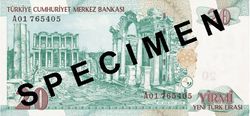 |
20 lira | 162 × 76 mm | Green | Mustafa Kemal Atatürk | Ruins of Ephesus | |
 |
 |
50 lira | 152 × 81 mm | Orange | Mustafa Kemal Atatürk | Cappadocia | |
 |
 |
100 lira | 158 × 81 mm | Blue | Mustafa Kemal Atatürk | Ishak Pasha Palace | |
| These images are to scale at 0.7 pixels per millimetre. For table standards, see the banknote specification table. | |||||||
9th Emission group
A new series of banknotes, the "E-9 Emission Group" entered circulation on 1 January 2009, with the E-8 group ceasing to be valid after 31 December 2009 (although still redeemable at branches of the Central Bank until 31 December 2019). The E-9 banknotes refer to the currency as "lira" rather than "new lira", and include a new 200 lira denomination.[5] The new banknotes have different sizes to prevent forgery.[6] The main specificity of this new series is that each denomination depicts a famous Turkish personality, rather than geographical sites and architectural features of Turkey.
| Banknotes of Emission 9 | |||||||
|---|---|---|---|---|---|---|---|
| Image | Value | Dimensions | Main colours | Description | |||
| Obverse | Reverse | Obverse | Reverse | ||||
| 5 lira | 64 × 130 mm | Brown | Mustafa Kemal Atatürk | Aydın Sayılı, diagrams of solar system, atom, ancient cave and an incorrect left-handed DNA helix. | |||
| 10 lira | 64 × 136 mm | Red | Mustafa Kemal Atatürk | Cahit Arf, Arf invariant, arithmetic series, abacus, binary | |||
| 20 lira | 68 × 142 mm | Green | Mustafa Kemal Atatürk | Architect Kemaleddin, Gazi University main building, aqueduct, circular motif and cube-globe-cylinder symbolizing architecture | |||
| 50 lira | 68 × 148 mm | Orange | Mustafa Kemal Atatürk | Fatma Aliye Topuz, flower and literary figures | |||
 |
 |
100 lira | 72 × 154 mm | Blue | Mustafa Kemal Atatürk | Buhurizade Itri, notes, instruments and Mevlevi figure | |
 |
 |
200 lira | 72 × 160 mm | Purple | Mustafa Kemal Atatürk | Yunus Emre, Yunus' mausoleum, rose, pigeon and the line "Sevelim, sevilelim" (Let us love, let us be loved) | |
| These images are to scale at 0.7 pixels per millimetre. For table standards, see the banknote specification table. | |||||||
See also
- Economy of Turkey
- Economy of Northern Cyprus
References
- ↑ International Organization for Standardization. "BISO 4217 Currency names and code elements". ISO. http://www.iso.org/iso/support/faqs/faqs_widely_used_standards/widely_used_standards_other/currency_codes/currency_codes_list-1.htm. Retrieved 2009-01-02.
- ↑ Official Gazette of the Republic of Turkey. "Law on the Currency of the Republic of Turkey". http://rega.basbakanlik.gov.tr/eskiler/2004/01/20040131.htm#3.
- ↑ Türkiye Cumhuriyet Merkez Bankasi (Central Bank of the Republic of Turkey) (19 December 2005). "Announcement on the Withdrawal of Turkish Lira Banknotes from Circulation". Official Gazette no. 26028, 19 December 2005, pages 89-90.. TCMB. http://www.tcmb.gov.tr/yeni/eng/. Retrieved 2008-01-05.
- ↑ Türkiye Cumhuriyet Merkez Bankasi (Central Bank of the Republic of Turkey). "Banknotes Withdrawn From Circulation and the Redemption Periods". "Banknotes" section of TCMB website.. TCMB. http://www.tcmb.gov.tr/yeni/eng/. Retrieved 2008-01-05.
- ↑ Türkiye Cumhuriyet Merkez Bankasi (Central Bank of the Republic of Turkey) (8 May 2007). "Announcement on the Withdrawal of New Turkish Lira Banknotes from Circulation". Official Gazette no. 26516, 8 May 2007, page 103.. TCMB. http://www.tcmb.gov.tr/yeni/eng/. Retrieved 2008-01-05.
- ↑ Turkish Daily News (2006-09-15). "TL banknotes to be in circulation in 2009". Archived from the original on 2007-09-30. http://web.archive.org/web/20070930170901/http://www.turkishdailynews.com.tr/article.php?enewsid=54176. Retrieved 2006-09-28.
- Krause, Chester L. and Clifford Mishler (1991). Standard Catalog of World Coins: 1801–1991 (18th ed. ed.). Krause Publications. ISBN 0873411501.
- Pick, Albert (1994). Standard Catalog of World Paper Money: General Issues. Colin R. Bruce II and Neil Shafer (editors) (7th ed.). Krause Publications. ISBN 0-87341-207-9.
- Sevket Pamuk (2000). A Monetary History of the Ottoman Empire. Cambridge University Press. ISBN 0-521-44197-8.
Further reading
- "Türk Lirası’nda yeni yüzler" (in Turkish). NTV-MSNBC. Anadolu Agency. 2008-10-03. http://www.ntvmsnbc.com/news/461129.asp. Retrieved 2009-01-06.
External links
- Articles about Ottoman Turkish currency (in Turkish)
- Banknotes of Turkey
- Turkish Central Bank (Banknote Museum page)
- Ottoman Empire coins
- Republic of Turkey coins and banknotes
- Images of the "new lira" banknotes and coins
- Coins from Turkey with pictures
- Turkish new lira official changeover Campaign
- Turkish Lira exchange rates over other currencies
Historical context
| Preceded by: Turkish kuruş Ratio: 100 kuruş = 1 (first) lira |
Currency of Turkey 1844 – December 31, 2004 Note: (First) |
Succeeded by: (Second) Turkish lira (called "New Turkish lira" January 1, 2005 – December 31, 2008) Reason: inflation Ratio: 1,000,000 (first) lira = 1 (second) lira |
| Preceded by: (First) Turkish lira Reason: inflation Ratio: 1,000,000 (first) lira = 1 (second) lira |
Currency of Turkey January 1, 2005 – Note: (Second) |
Succeeded by: Current |
| Current TRY exchange rates | |
|---|---|
| From Google Finance: | AUD CAD CHF EUR GBP HKD JPY USD |
| From Yahoo! Finance: | AUD CAD CHF EUR GBP HKD JPY USD |
| From XE.com: | AUD CAD CHF EUR GBP HKD JPY USD |
| From OANDA.com: | AUD CAD CHF EUR GBP HKD JPY USD |
|
||||||||||||||||||||||||||||||||||||||||||||||
|
||||||||||||||||||||
